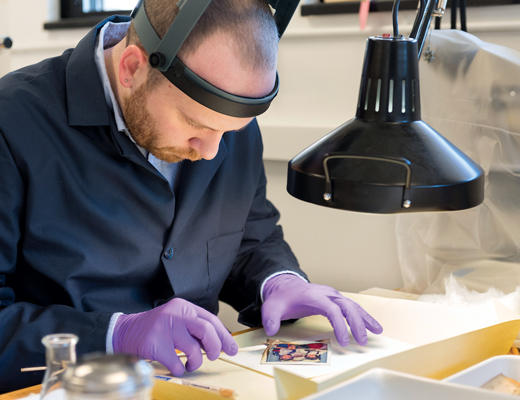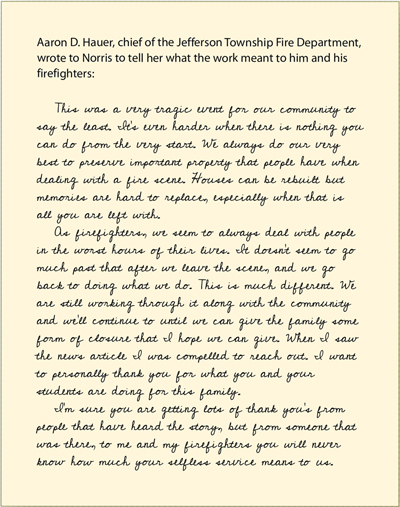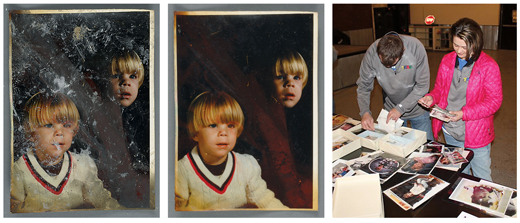Rebuilding Memories
Art conservation students salvage photos of a family lost to tragic fire

OUR STUDENTS | They could have sent these photographs by airmail or some kind of ground transportation. They would have reached the Ohio home of Ricky and Traci Harris well enough.
But this is precious cargo, the kind that needs a “Handle With Care” label, the kind that cries out for special delivery, the kind you don’t take chances with.
That’s how University of Delaware professor Debra Hess Norris and doctoral student Michael Emmons saw it, so they traveled this spring to Washington Court House, Ohio, on Friday, March 13, to return a treasure trove of family memories to the Harris’ home.
The photographs—hundreds of them—were just about the only items salvaged from a Dec. 26, 2014 house fire that claimed the lives of the Harris’ three sons—Kenyon, 14, Broderick, 11, and Braylon, 9—and Ricky Harris’ mother, Terry, 60.

The three boys had spent Christmas night with their grandmother, just two doors down from their own house, so she wouldn’t be alone. Just after 4 a.m., the fire broke out and quickly engulfed the small ranch house.
Emmons, AS14M, a high-school friend of Ricky Harris who is pursuing his doctorate in art conservation at UD, found the photographs in Harris’ garage when he went to see his devastated friend the day after the fire. Someone had rescued them from the fire scene and spread them out on the garage floor, wall-to-wall, to dry.
Many were charred around the edges, some were stuck together, warped. All had been soaked with firehose quantities of water.
Emmons wasn’t sure what to do or whether anything could be done, but he believed Norris would have a suggestion. As the Henry Francis du Pont Chair in Fine Arts and the chair of UD’s Department of Art Conservation, she is an internationally recognized expert in photograph conservation. He contacted her immediately.
When Norris heard what had happened, she invited him to have the photographs shipped to Winterthur, where she was about to teach a three-week photograph conservation class to first-year graduate students in the Winterthur/University of Delaware Program in Art Conservation. They would evaluate the photographs and do what they could to clean, flatten and stabilize them.
A box full of photographs arrived at Winterthur just before the first class on Jan. 5.
Norris said she and her students planned to take the photographs out and begin to sort through them. But when they opened the envelope, an acrid smell of smoke filled the room, enough to make some students’ eyes water. Addressing that smell became an important part of the project.
Students worked for hundreds of hours, and Norris said everyone felt a connection with the Harris family, though they had never met. Being able to develop their skills while helping a family at such a time of loss made the work especially meaningful, many in the class said.

“It is so personal and emotional for the family, and our priority is to help them,” Leah Bright, AS17, a native of Fairbanks, Alaska, said during a work session in January.
In addition to treating the photographs, students kept copious notes, recording the methods and materials used, their rationale for using various approaches, the ethical considerations they included in their decisions, where they encountered challenges and what they recommend for others facing similar situations.
As the work progressed, Ricky Harris said it was a source of comfort for him and his wife.
“That this great big place that could be doing so many other things is doing this for us, it helps,” he said in January of this year.
Norris and Emmons delivered the treated photographs—more than 200 in total, each one packaged in a protective sleeve—to the Harris family earlier this spring.
“I could see on Ricky’s face this really strong emotion,” Emmons said. “He was fighting back quite a bit, I’m sure, as he started looking at the photos. There were a lot of tears and some laughter, too.”
Later, Ricky told local reporters it always made him a little bit sad to see photos, even when his children were alive, because it reminded him of times gone by.
“You’re almost mourning the time when your children were younger,” Emmons said. “So to look at them now, when they were gone, was painful as well as gratifying. It was one of those events with completely mixed emotions—the joy of his family getting those photos back, but obviously a lot of raw pain as they looked through them.”
Emmons had no idea when he found the photographs in Harris’ garage months before that anything could be done to save them. He is amazed by what Norris and her students accomplished in just three weeks, and he is grateful to Norris for not only sharing her expertise and steering that work but for going with him to deliver the photographs to the family in person.
“Obviously it is not going to bring his mother or his children back,” Emmons said. “There is no replicating having those people with you and giving them a hug. Maybe the next best thing is having artifacts. To have images of the family is pretty special.”
Article by Beth Miller




